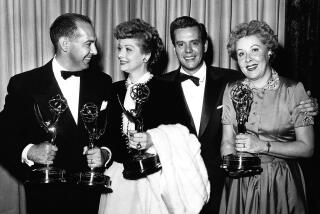A ‘Bridge’ that’s worth crossing
- Share via
The Life After: Critics and audiences approved of “Bridge to Terabithia,” a heartwarming family film based on Katharine Paterson’s 1977 Newbery Award-winning novel.
The film, which arrives Tuesday on DVD, was one of the early box-office hits of the year, earning $81 million stateside, with $40.1 million more internationally.
For the record:
12:00 a.m. June 24, 2007 For The Record
Los Angeles Times Tuesday June 19, 2007 Home Edition Main News Part A Page 2 National Desk 0 inches; 25 words Type of Material: Correction
‘Mame’: The DVD File column in Sunday’s Calendar section said that the Lucille Ball musical film “Mame” was released in 1973. It was in 1974.
For The Record
Los Angeles Times Sunday June 24, 2007 Home Edition Sunday Calendar Part E Page 2 Calendar Desk 0 inches; 24 words Type of Material: Correction
“Mame”: The DVD File column last Sunday incorrectly said that the Lucille Ball musical film “Mame” was released in 1973. It was in 1974.
For The Record
Los Angeles Times Sunday June 24, 2007 Home Edition Main News Part A Page 2 National Desk 0 inches; 27 words Type of Material: Correction
‘Mame’: The DVD File column in the June 17 Calendar section said that the Lucille Ball musical film “Mame” was released in 1973. It was in 1974.
Josh Hutcherson and AnnaSophia Robb play two fifth-graders from widely diverse backgrounds who become best friends. They escape from the pressures of their lives by swinging across a creek on their “enchanted” rope into the make-believe forest of Terabithia.
“Bridge” also marked the live-action directorial debut of Gabor Csupo, best known for his animation work on “The Rugrats.”
Redhead alert
Having a Ball: “I Love Lucy” turned Lucille Ball into a superstar. But Ball had been kicking around Hollywood for nearly two decades before she and husband Desi Arnaz created sitcom history in 1951.
Warner Home Video’s new “Lucille Ball Film Collection,” which debuts Tuesday, features five movies she made before and after her days as Lucy Ricardo. Directed by Dorothy Arzner, 1940’s “Dance, Girl, Dance” has a feminist slant; Maureen O’Hara plays a young innocent who ventures to New York with dreams of becoming a classical dancer, but she ends up having to take a job as a “stooge” for a loudmouth striptease artist named Bubbles (Ball).
Many consider Ball’s performance in 1942’s “The Big Street” the best in her half-century career. Based on a Damon Runyan story, the drama finds Ball playing the beautiful but selfish star of a gangster’s New York nightclub. Henry Fonda, who would reunite with Ball for 1968’s “Yours, Mine and Ours,” is a timid busboy named Little Pinks who adores Ball’s Gloria. When Gloria is crippled after she falls down the stairs, Little Pinks slavishly takes care of her.
Ball’s flaming red hair pops off the screen in the lavish 1943 musical “DuBarry Was Lady,” based on the hit Broadway musical by Cole Porter. She plays a showgirl who is the object of affection for a men’s room attendant (Red Skelton).
Rounding out the collection is the 1963 comedy “Critic’s Choice” with Bob Hope and the 1973 musical “Mame.”
-- Susan King
More to Read
Only good movies
Get the Indie Focus newsletter, Mark Olsen's weekly guide to the world of cinema.
You may occasionally receive promotional content from the Los Angeles Times.








